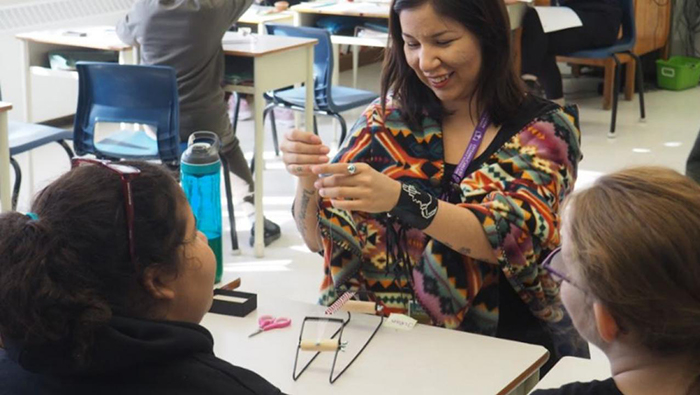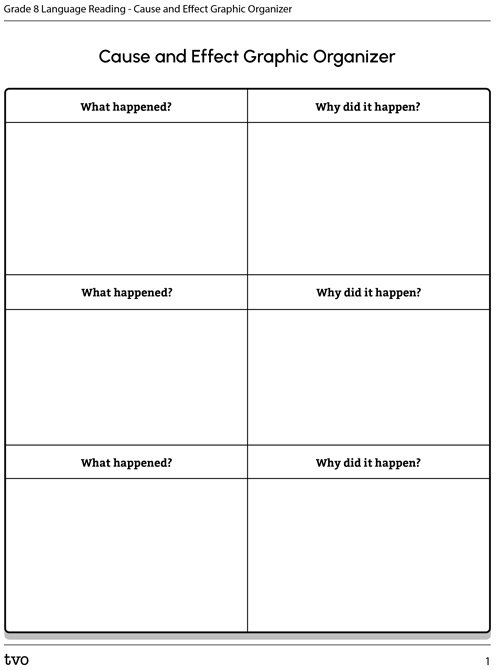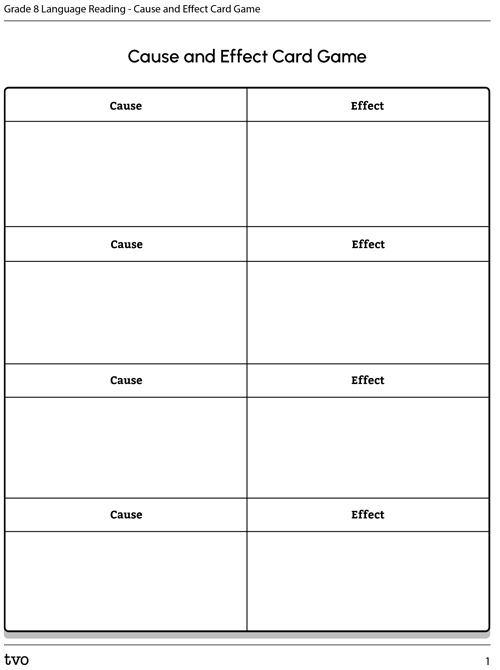Minds On
Matching
Consider the cause and effect events in the following picture.
What strategies did you use to determine a cause and effect relationship between each pair of events?

Match each cause with its effect to create a relationship.
Action
Introducing cause and effect relationships in text

To put it simply, all things happen for a reason! Every cause has an effect.
A cause is the reason why something happens, and an effect is what happens as a result of the cause.
While we experience cause and effect in our daily lives, it’s also an organizational pattern that we can use as readers to help us understand why things happen the way they do in a text. This applies to both fiction and nonfiction texts.
These are two types of cause-and-effect relationships:
- Explicit cause and effect relationships: the relationship between the cause (why) and effect (what) is clearly expressed.
- Implicit cause and effect relationships: sometimes you will need to “read between the lines” and infer the cause or effect because it is not clearly stated in the text.
Let’s explore how to determine cause and effect relationships.
Signpost words
We can use signal or ‘signpost’ words to determine cause and effect relationships. Signal words express a connection between ideas and help us to answer implicit or unstated questions including, “What happened?” (effect) and “Why did that happen? (cause).
Example 1:
Since it was starting to become cold in the house, Naomi built a fire in their fireplace.
Cause: It was starting to become cold in the house.
Effect: Naomi built a fire in their fireplace.
Signal word: “Since”
Example 2:
The city finally re-opened the public tennis courts, so Vincent and Rémy made a plan to play tennis together over the weekend.
Cause: The city finally re-opened the public tennis courts.
Effect: Vincent and Rémy made a plan to play tennis together over the weekend.
Signal word: “So”
Sort the following words that can be used to indicate cause and effect. Complete Sorting Signal Words in your notebook or using the following fillable and printable document.
| Cause (Why) | Effect (What) |
|---|---|
|
Word box So, Due to, Because, Since, Therefore, On account of, The reason for, Now that, Then, As a result, This resulted in, Consequently. |
|
Press the ‘Activity’ button to access the Sorting Signal Words.
Press ‘Hint’ to reveal answers to Sorting Signal Words.
| Cause (Why did it happen?) | Effect (What happened?) |
|---|---|
|
Because |
So |
What happened? Why?
Explore the news article, "How beading is helping these students learn about mathematical concepts — and Indigenous culture" and identify examples of cause-and-effect relationships. Be sure to also explain how each example helps to communicate meaning and information in an easy-to-understand way.
Press ‘Reveal’ to reveal a Tip.
TIP: Consider the words and clues that you used to determine the pattern being used.
Record your ideas using the following Cause and Effect Graphic Organizer or another method of your choice.

Press TVO.org to access How beading is helping these students learn about mathematical concepts — and Indigenous culture.
TVO dot org (Opens in a new tab)
Press the Activity button to access the Cause and Effect Graphic Organizer.
Activity (Open PDF in a new tab)Consolidation
Card game
Use the cause-and-effect examples you identified in the Action section to create a matching game (like the one in the Minds On!).
Record your examples using a method of your choice or using the following Cause and Effect Card Game template.
If possible, share your game with a partner.

Press the Activity button to access the Cause and Effect Card Game.
Activity (Open PDF in a new tab)Reflection
As you read the following descriptions, select the one that best describes your current understanding of the learning in this activity. Press the corresponding button once you have made your choice.
I feel...
Now, expand on your ideas by recording your thoughts using a voice recorder, speech-to-text, or writing tool.
When you review your notes on this learning activity later, reflect on whether you would select a different description based on your further review of the material in this learning activity.
Press ‘Discover More’ to extend your skills.
Discover MoreUsing cross-curricular connections Let’s get a little creative with cause-and-effect relationships! We have spent time analyzing and discussing how authors use this model in their written work. Let’s now consider the different subject areas we learn and how we could explore a cause-and-effect relationship within the topics of this subject.
With a partner, if possible, choose 4 different subject areas from the following list and consider a cause-and-effect relationship that you could possibly read or listen to a story, article, or issue about pertaining to this subject area. Create a mind map, visual, written or oral representation of your choice to record your ideas:
- history
- science
- physical education
- health
- visual Arts
- music
- geography
- drama
- dance
- mathematics
- french
- media literacy